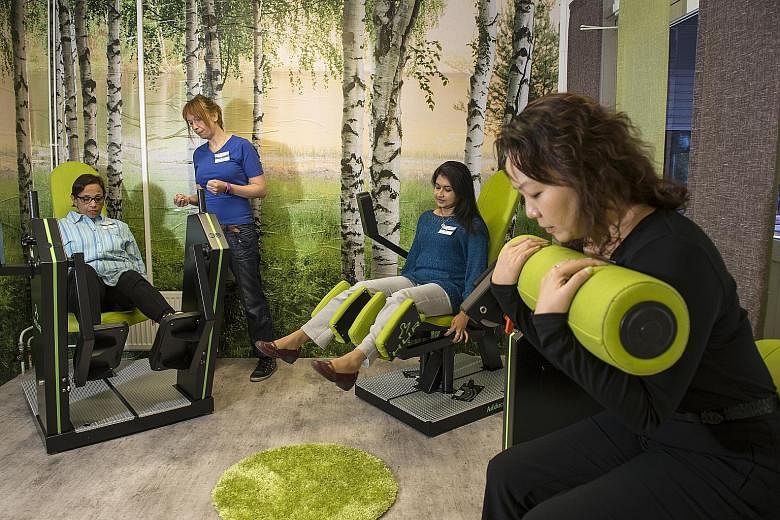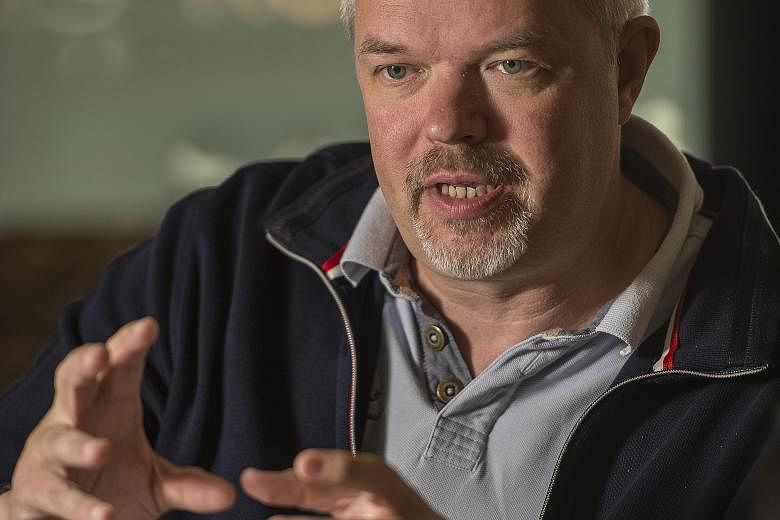Put the elderly into gyms, not between blankets. And to back its call, the Lien Foundation is bringing in $2.2 million worth of high-tech gym equipment from Finland which has been specially tailored for seniors.
These machines use an air-pressure system which is gentler on muscles and joints. Weights can be increased in 100g steps instead of the usual 5kg in typical machines.
Smart cards ensure equipment settings adjust automatically to the user, and a senior's performance on the machine is tracked by software so physiotherapists can tweak individualised regimens accordingly.
Some of the pneumatic gym equipment for 2,000 senior citizens in six nursing homes and six eldercare centres arrived in April and the rest will get here next month so as to encourage active ageing habits among the old.
"Research is showing that instead of overprotecting seniors, they should be put in a gym to build up their strength to prevent incidents such as falls," said Lien Foundation chief executive Lee Poh Wah.
The foundation is ensuring that staff at these homes and centres have the know-how to make full use of the machines.
A group of 10 physiotherapists were in Finland two weeks ago to be trained on how to use the machines and their software. Another 14 will be trained there next month.
It is also partnering Kokkola University in Finland, which is also grappling with an ageing population, to see how exercise can be tailored for the elderly in Singapore to improve their physical and mental health.
The new equipment has already proven to be a hit. Mr Tan Cheng Hong, 77, had been worried about going to the toilet, fearing that his arthritic knees might give way anytime. But he is now able to do 20kg presses on a leg machine and this has given him more confidence.
His fellow resident at Peacehaven nursing home also used to grapple with high blood pressure, and how it could affect her on outings. "Since using the machines, my blood pressure has stabilised," said Ms Jennifer Ng, 75, adding that she now feels more energetic.
Healthcare workers said that being able to see their progress on the machines motivates the elderly to work out.
"Some elderly residents think that it is not their place to be in a gym and they are frightened to push themselves but that changes when they see results," said Ms May Wong, manager of therapy services at St Joseph's Home.
Ms P. Manchu, manager at Man Fut Tong nursing home, said it had been searching for such equipment for the past two years as "the usual gyms are unsuitable for the elderly, especially those with osteoporosis".
Exercise therapist Andrew Yeo from Peacehaven nursing home said physical inactivity is a big problem among senior citizens.
"The frail are often caught in a vicious circle of inactivity. Afraid of falling, they don't exercise and this makes them weaker to the point of being bed-bound," he said.
In the early 1990s, Finland was one of the first few countries to push for strength training for the elderly. Now, over 90 per cent of its elderly who are 75 years and above are able to continue to live at home. Only 3 per cent live in long-term institutional care centres.
Such programmes also help reduce healthcare costs, said Dr Magnus Bjorkgren, head of the health science unit at Finland's Jyvaskyla University. About 7,000 hip fractures occur in Finland each year and 90 per cent are due to falls. The cost of a hip fracture is about $40,000 for the first year. According to research, strength and balance training can cut falls by as much as half.
"Decision makers are now seriously putting resources into preventive action to keep the elderly active instead of having just a corrective philosophy," said Dr Bjorkgren.
The Government in Singapore also unveiled a new $3 billion five-year Action Plan for Successful Ageing last week.
On the cards are active ageing hubs to be built in future Housing Board developments. They will be similar to current senior activity centres but will be larger and incorporate both social programmes and rehabilitation or daycare services.
"This move will change the way people approach ageing and help to enhance the public perception of ageing," said Mr Lee. "Longevity must be coupled with a life that is worth living."



